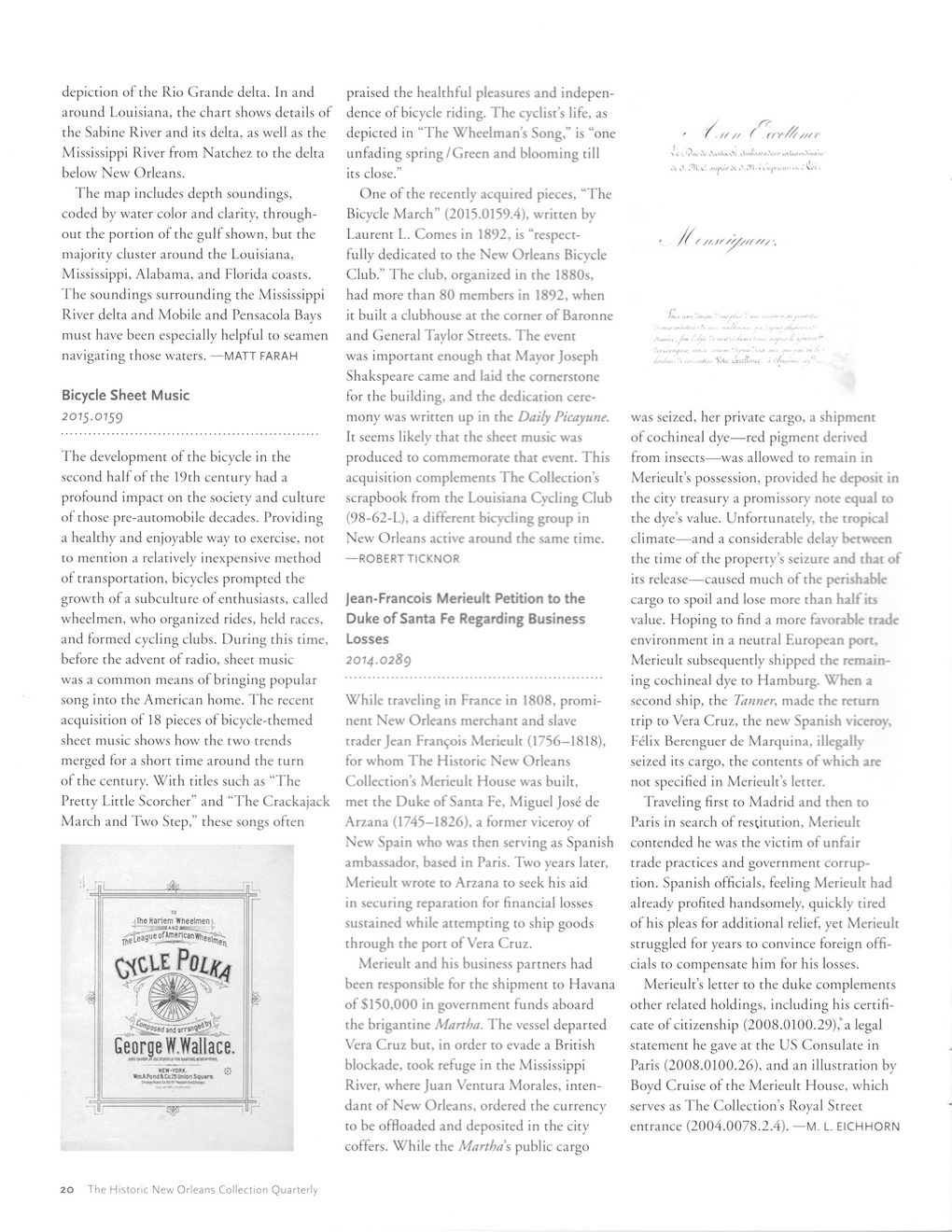This text was obtained via automated optical character recognition.
It has not been edited and may therefore contain several errors.
depiction of the Rio Grande delta. In and around Louisiana, the chart shows details of the Sabine River and its delta, as well as the Mississippi River from Natchez to the delta below New Orleans. The map includes depth soundings, coded by water color and clarity, throughout the portion of the gulf shown, but the majority cluster around the Louisiana, Mississippi, Alabama, and Florida coasts. The soundings surrounding the Mississippi River delta and Mobile and Pensacola Bays must have been especially helpful to seamen navigating those waters. —MATT FARAH Bicycle Sheet Music 2075.0759 The development of the bicycle in the second half of the 19th century had a profound impact on the society and culture of those pre-automobile decades. Providing a healthy and enjoyable way to exercise, not to mention a relatively inexpensive method of transportation, bicycles prompted the growth of a subculture of enthusiasts, called wheelmen, who organized rides, held races, and formed cycling clubs. During this time, before the advent of radio, sheet music was a common means of bringing popular song into the American home. The recent acquisition of 18 pieces of bicycle-themed sheet music shows how the two trends merged for a short time around the turn of the century. With titles such as “The Pretty Little Scorcher” and “The Crackajack March and Two Step,” these songs often praised the healthful pleasures and independence of bicycle riding. The cyclist’s life, as depicted in “The Wheelman’s Song,” is “one unfading spring/Green and blooming till its close.” One of the recently acquired pieces, “The Bicycle March” (2015.0159.4), written by Laurent L. Comes in 1892, is “respectfully dedicated to the New Orleans Bicycle Club.” The club, organized in the 1880s, had more than 80 members in 1892, when it built a clubhouse at the corner of Baronne and General Taylor Streets. The event was important enough that Mayor Joseph Shakspeare came and laid the cornerstone for the building, and the dedication ceremony was written up in the Daily Picayune. It seems likely that the sheet music was produced to commemorate that event. This acquisition complements The Collection’s scrapbook from the Louisiana Cycling Club (98-62-L), a different bicycling group in New Orleans active around the same time. —ROBERT TICKNOR Jean-Francois Merieult Petition to the Duke of Santa Fe Regarding Business Losses 2074.0289 While traveling in France in 1808, prominent New Orleans merchant and slave trader Jean Francois Merieult (1756-1818), for whom The Historic New Orleans Collection’s Merieult House was built, met the Duke of Santa Fe, Miguel Jose de Arzana (1745-1826), a former viceroy of New Spain who was then serving as Spanish ambassador, based in Paris. Two years later, Merieult wrote to Arzana to seek his aid in securing reparation for financial losses sustained while attempting to ship goods through the port of Vera Cruz. Merieult and his business partners had been responsible for the shipment to Havana of $150,000 in government funds aboard the brigantine Martha. The vessel departed Vera Cruz but, in order to evade a British blockade, took refuge in the Mississippi River, where Juan Ventura Morales, inten-dant of New Orleans, ordered the currency to be offloaded and deposited in the city coffers. While the Martha's public cargo // /<// f r/y///’ //// , a.-.\ :'tu: ;x "■ • // r //.//■ /?//// /// , was seized, her private cargo, a shipment of cochineal dye—red pigment derived from insects—was allowed to remain in Merieult’s possession, provided he deposit in the city treasury a promissory note equal to the dye’s value. Unfortunately, the tropical climate—and a considerable delay between the time of the property’s seizure and that of its release—caused much of the perishable cargo to spoil and lose more than half its value. Hoping to find a more favorable trade environment in a neutral European port, Merieult subsequently shipped the remaining cochineal dye to Hamburg. When a second ship, the Tanner, made the return trip to Vera Cruz, the new Spanish viceroy, Felix Berenguer de Marquina, illegally seized its cargo, the contents of which are not specified in Merieult’s letter. Traveling first to Madrid and then to Paris in search of restitution, Merieult contended he was the victim of unfair trade practices and government corruption. Spanish officials, feeling Merieult had already profited handsomely, quickly tired of his pleas for additional relief, yet Merieult struggled for years to convince foreign officials to compensate him for his losses. Merieult’s letter to the duke complements other related holdings, including his certificate of citizenship (2008.0100.29),* a legal statement he gave at the US Consulate in Paris (2008.0100.26), and an illustration by Boyd Cruise of the Merieult House, which serves as The Collection’s Royal Street entrance (2004.0078.2.4). —M. L. EICHHORN 20 The Historic New Orleans Collection Quarterly

New Orleans Quarterly 2015 Fall (22)